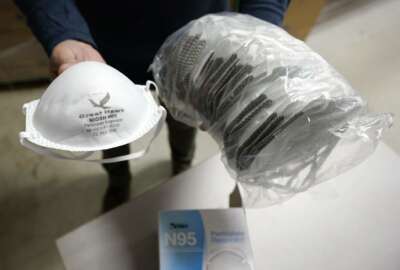Rise in OTAs for federal contracting brings mixed blessings
The IBM Center for the Business of Government has sponsored a detailed analysis of OTAs and how the government is using them.
Best listening experience is on Chrome, Firefox or Safari. Subscribe to Federal Drive’s daily audio interviews on Apple Podcasts or PodcastOne.
Like discovering a long buried pair of jeans that becomes your new favorite, other transaction agreements (OTAs) are a procurement methodology that falls outside of the Federal Acquisition Regulation and its Defense supplement. Use of OTAs has grown rapidly across the government in the last couple of years but it might be a mixed blessing. Now the IBM Center for the Business of Government has sponsored a detailed analysis of OTAs and how the government is using them. For the highlights, co-author and Hacking for Defense adviser Stan Soloway spoke to Federal Drive with Tom Temin.
Interview transcript:
Tom Temin: And of course, you’ve been following Defense acquisition both from the inside and the outside for many, many years as a practitioner and consultant and trade operation head, what’s the big takeaway from OTAs that we’ve learned in the increasing use of them by Defense over the last couple of years?
Stan Soloway: Well I think there are two or three things that the report highlights, and couple of them everybody knows. You mentioned in the lead-in that the growth has been astronomical over the last five or six years. From like $500 million in spend to approaching $9 billion, I believe, will be the final number for this year. Now, keep in mind, some of that latter growth is directly connected by the weight of the pandemic and the use of other transactions to support the vaccine research, but it has grown dramatically. The second piece that is very important to recognize that what has changed with OTAs, particularly for DoD, and to a certain extent for the Department of Homeland Security, is that in 2016, Congress gave DoD permission to use this methodology, to use non-FAR tools — essentially commercially negotiated contracts — not just for research and development, which is how OTAs were designed, what they were designed for, but all the way through production and implementation of whatever the solution of the product might be. That changed the game dramatically and really opened the floodgates. So in the meantime, there has now risen, as often does when you see these kinds of changes, a lot of questions being raised. Are they being used appropriately? Where do we have to have the Federal Acquisition Regulation govern procurement? Where is it okay not to have it and so forth? And what we did is we decided to step back and say, well, maybe those are the wrong question. So it seems that’s the real question, A., is Production Authority actually having an impact? Are we getting what Congress intended? And second, are OTAs, themselves, leaving the Federal Acquisition Regulation aside, actually consistent with the ethos of public procurement? And if so, the question of when and where you can use them is less important than how to make sure they’re done right because they could become something of a normalized alternative to the FAR as opposed to some exotic sidebar. So that was how we kind of came at the report. And I think we found two things. One was Production Authority is not having the effect one had hoped because there is this tendency in the system, the further you get along in the process, the more we have what they call FAR creep — the old methodology start creeping back in and are driving people back out of the market who had come back, who’d come in initially, because the OTAs made it possible. And second, that there are a number of things that we need to be doing to improve how OTAs are done, particularly, or most importantly, around workforce capability and workforce preparation.
Tom Temin: Because I think of the FAR as essentially supporting the competition in contracting act and turning that into a formalized process. But over the years, it’s been added to and added to and added to, and has a great deal of, I guess friction, and the big complaint is how long it takes and so on, and that’s been litigated over and over again for decades. So the question, I guess, then did you find that use of OTAs can also foster a sufficient level of competition, that everybody has an equal crack at that federal dollar?
Stan Soloway: Yeah, in fact, I would say yes, emphatically. That is not an issue with OTAs. For two reasons. One is there are two methodologies that are used when other transactions are implemented. One is just an open door policy, literally, if you look at like the Defense Innovation Unit in California, which has really done a lot with OTAs, really, that’s their methodology, they put out a statement of need, or problem statement, that anybody in business can respond to, it’s a wide open field. Then once you get into it, you’d have to demonstrate capability and so forth, that it’s initially made known to and available to anybody. But even those are the transactions that are done through what are called consortiums, there are functional areas amid the Undersea Warfare or Command and Control Communications, or what have you. There are different kinds of consortiums that are nonprofits that are set up to sort of manage the process. They have hundreds, if not thousands of members, and all of those members have access to and learn about any OTA that is in their field. So to that extent, it’s even more competitive than the typical multiple award contract in government. So competition isn’t really an issue with OTAs. I think that you always have the challenge of making sure the universe is broad enough. So even if you’re in a consortium, that’s great, but only the people in the consortium know about the opportunity. It’s still a very broad, big number, but there may be others. But the other issues that you when you talk about what the FAR is built around, you have to think about transparency. We have to think about accountability. And when we think about things like ethics and socio economics. And so, on the transparency side, we looked carefully at that, we actually evaluated a half a dozen, randomly selected, redacted, other transaction agreements to see what degree of transparency they have. And we found that they have pretty much all of the transparency you’d have in a FAR contract — the deliverables are clearly defined, the accountability is pretty clearly defined. The two areas where there’s some work that needs to be done is, one, if they’re going to continue to grow, we’re gonna have to find a way to adapt our socio economic policies to them because they currently don’t apply at all. And that is a part of federal procurement that’s not going to change. In fact, it’s likely to grow. And as I said, second, it’s really how do we get the workforce comfortable with a very, very different way of doing business, so that we can take advantage of something that really does enable most commercial entities in the country to play? And if I can just add one last point, to put a fine point on your question, and that is, back in the late ’90’s when I was in the Defense Department, we did a study of OTAs to see what they looked like, and we found they looked a lot like what’s called FAR Part 12, which I know you’re familiar with, which is the part of the Federal Acquisition Regulation designed to enable commercial contracting. That was in the ’90’s. Since then, we’ve added 150, or 160, new clauses and FAR Part 12 has been totally diluted. We believe that, based on what we saw, they still look very much like FAR Part 12 as it was designed and intended by Congress and by the reg writers back in the ’90’s. So if we got back to the basics, you’re back to something that looks an awful lot like another transaction.
Tom Temin: Interesting. We’re speaking with Stan Soloway, senior advisor to Hacking for Defense, and co-author of Other Transaction Authorities, published by the IBM Center for the Business of Government. And getting back to that point of Production Authority, which you write is the single most important advance in OTA policy in decades, and you had mentioned earlier has not met the intended goal of incentivizing more innovation, and the FAR didn’t seem to do that. So is the issue government itself? What can OTA do, or how can people use OTA, at this point, to push the innovation idea that Congress intended?
Stan Soloway: I don’t think the fact that the Production Authority has not met its intended objective means that it’s not driving innovation. I think there’s every reason to believe we’re getting innovation through OTAs. What’s happening in Production Authority, and it’s still relatively new, it’s only been a few years that they’ve had it, and there’s no great data. That’s one of the challenges. And we do call and report for a much better set of data collection so we can continually analyze. But, the issue that we’re seeing with Production Authority is if your company is a commercial company, it’s a start up, or an established company, just a non traditional government contractor, and you come into the government through an OTA, and it is done in very commercial terms and conditions, when you get to Production Authority, what we’re finding too often is that the government is falling back on traditional Federal Acquisition Regulation clauses, particularly around intellectual property, and sometimes including audit rights, which gets you into government unique cost accounting, as opposed to relying on commercial cost accounting standards. And, those things tend to drive the company’s back out of the market. So we may be getting the innovation that they initially bring in. But you’re losing access to the human capital and the technology and engineering expertise that drove that initial innovation for the next stage and the stage thereafter and the stage thereafter, if you will, how that sort of expanding circle of capability. And so what often is happening, and this is, as I said, mostly anecdotal, but it’s pretty universal with everybody we’ve interviewed for this report is that they’re either selling or licensing their technology to a partner, or they’re turning the licensing over to the government for the immediate purpose that it was sold only, and walking away. So, the challenge with the Production Authority is you want to keep the ecosystem moving smoothly, you don’t want people coming in with a capability, demonstrating real innovation, and then walking away and not having access to them for the next one. So that’s a challenge with Production Authority. I think we’re probably getting a lot of innovation. But we’re not scaling it like we could because of this tendency to bring the old FAR clauses back into play.
Tom Temin: And do you see OTAs and FAR simply existing and rolling along side-by-side with the PAR procurements bigger in dollar volume than OTAs? Or is there some sort of reckoning coming, that maybe it’s time to look at the whole thing fresh again, as they did in 1958?
Stan Soloway: You know, Tom, I think this is a really great question. And then I think it’s the core question. I think we basically concluded in the report, that is if we address some of the challenges that we know exist — deal with issues like the FAR creep we call, deal with the workforce challenges, address how we can align the OTAs with some of the other parts of public procurements that are not in them, such as socio economic rules and so forth — that you could see OTAs becoming an equal partner, almost, to the FAR, just another tool in the toolbox in the acquisition ecosystem. And that leads you to the question Jason Knudson, my co-author, and I started with which was, is the primacy of the FAR being challenged, or is this really just as I said earlier, an exotic sidebar that you use in certain circumstances. I think the former is more likely if we address some of these core issues. If we don’t address them, it will continue to just be an alternative methodology that has limited use, but it does have real potential.
Tom Temin: Stan Soloway is senior adviser to Hacking for Defense, and co-author of Other Transaction Authorities, published by the IBM Center for the Business of Government. Thanks so much for joining me.
Stan Soloway: Great to talk to you, Tom. Thank you.
Copyright © 2025 Federal News Network. All rights reserved. This website is not intended for users located within the European Economic Area.
Tom Temin is host of the Federal Drive and has been providing insight on federal technology and management issues for more than 30 years.
Follow @tteminWFED






